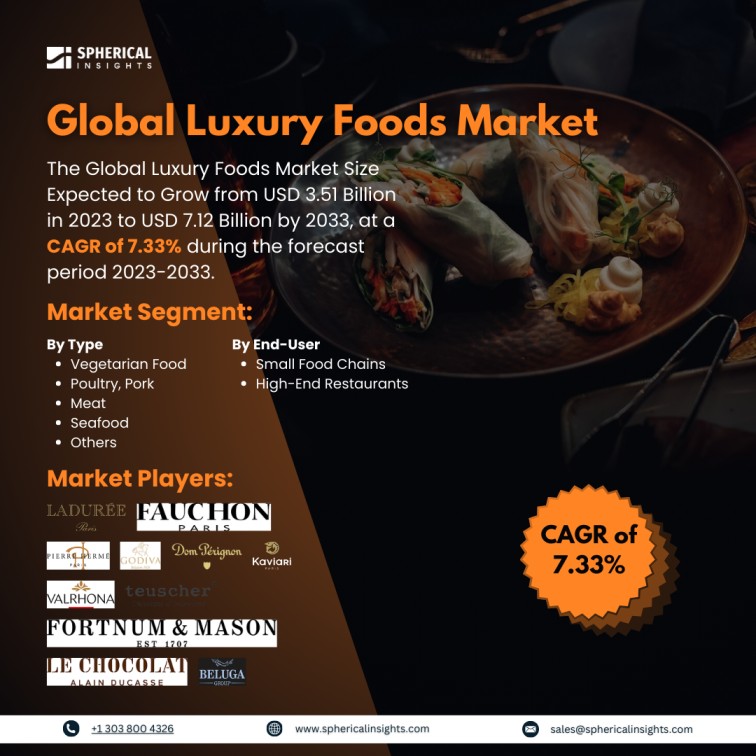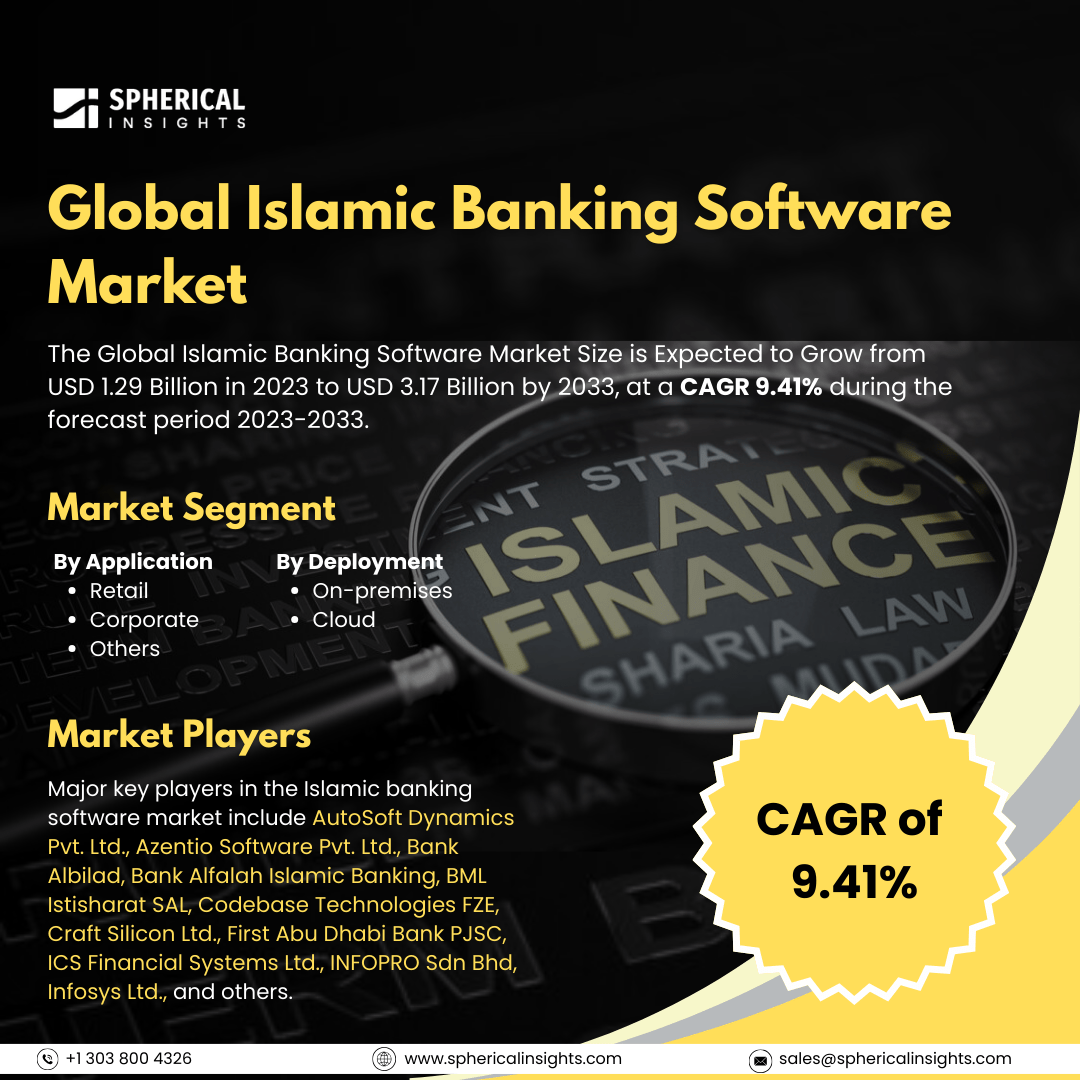Global Luxury Foods Market Size to Exceed USD 7.12 Billion by 2033
According to a research report published by Spherical Insights & Consulting, the Global Luxury Foods Market Size Expected to Grow from USD 3.51 Billion in 2023 to USD 7.12 Billion by 2033, at a CAGR of 7.33% during the forecast period 2023-2033.
Browse 210 market data Tables and 45 Figures spread through 190 Pages and in-depth TOC on the Global Luxury Foods Market Size, Share, and COVID-19 Impact Analysis, By Type (Vegetarian Food, Poultry, Pork, Meat, Seafood, and Others), By End-User (Small Food Chains and High-End Restaurants), and By Region (North America, Europe, Asia-Pacific, Latin America, Middle East, and Africa), Analysis and Forecast 2023 – 2033
A sector of the culinary business known for its fine flavors, premium ingredients, and outstanding dining experiences is represented by the luxury foods market. The growing global food tourism industry is expected to fuel the growth of the luxury foods sector. A key cultural factor driving the worldwide food service business has been the increase in disposable money and the number of people choosing to travel to more traditional lifestyles that prioritize financial savings. The general public is more eager to travel and experience new places, including fine dining. For example, according to research by the international credit reporting firm Experian, 63% of Gen Z and nearly 59% of millennials prefer to spend money on life experiences such as traveling or going to concerts over accumulating savings for the future. Additionally, the general public's growing use of credit cards is expected to fuel additional growth in the global luxury foods sector. The staggeringly large proportion of residents who use credit cards for all purchases is a result of increased public knowledge and credit card companies' increasingly aggressive marketing strategies. Nearly 82% of US citizens use credit cards, according to studies. This enables them to purchase a product first and then, if feasible, pay for it later. However, the high cost of luxury meals is expected to limit their global market. The cost of luxury foods is intrinsic. They are not intended for frequent eating because this would go against the primary attributes of luxury meals, which are exclusivity and uniqueness.
The seafood segment held the highest share in 2023 and is anticipated to grow at a significant CAGR during the projected timeframe.
Based on type, the global luxury foods market is categorized as vegetarian food, poultry, pork, meat, seafood, and others. Among these, the seafood segment held the highest share in 2023 and is anticipated to grow at a significant CAGR during the projected timeframe. Oysters and fugu, often called pufferfish, are among the priciest seafood luxury items. The latter has a distinct salty flavor and texture. Although raw oysters might be costly, they can also be cooked with other foods to enhance the flavor.
The high-end restaurants segment held the highest share in 2023 and is anticipated to grow at a significant CAGR during the projected timeframe.
Based on the end-user, the global luxury foods market is categorized as small food chains and high-end restaurants. Among these, the high-end restaurants segment held the highest share in 2023 and is anticipated to grow at a significant CAGR during the projected timeframe. Elite dining establishments or restaurants serve luxury cuisine, which has been refined over years of practice.
North America is projected to hold the largest share of the global luxury foods market over the forecast period.
North America is projected to hold the largest share of the global luxury foods market over the forecast period. The United States, Canada, and Mexico are the main countries driving regional growth. Mexico had the most demand for upscale foods in 2022. According to a recent survey, over 45% of Mexicans said they intended to purchase upscale cuisine in the upcoming years. The per capita incomes of the US and Canada are high. For example, the United States leads the world in economic growth. It is home to a sizable population as well as well-known, wealthy celebrities.
Europe is expected to grow at the fastest CAGR growth of the global luxury foods market during the forecast period. Europe holds a significant position in the gastronomic globe. The regional food business in Europe is generating a significant amount of revenue. Furthermore, Europe's culture of exquisite dining promotes regional market growth.
Competitive Analysis
Major vendors in the global luxury foods market are Ladurée, Fauchon, Pierre Hermé, Godiva, Dom Pérignon, Valrhona, Kaviari, Fortnum & Mason, Alain Ducasse Chocolat, Teuscher, Beluga Group, and others.
Key Target Audience
- Market Players
- Investors
- End-users
- Government Authorities
- Consulting and Research Firm
- Venture capitalists
- Value-Added Resellers (VARs)
Key Market Development
- In October 2023, the luxury lifestyle group Ce La Vi will be acquired by ADMO, the joint venture between Alpha Dhabi and Monterock International of Dubai, expanding its portfolio in the food and beverage, entertainment, and leisure sectors. Additionally, ADMO hopes to "substantially extend" its lifestyle presence in eastern countries with this move.
Market Segment
This study forecasts revenue at global, regional, and country levels from 2020 to 2033. Spherical Insights has segmented the global luxury foods market based on the below-mentioned segments:
Global Luxury Foods Market, By Type
- Vegetarian Food
- Poultry, Pork
- Meat
- Seafood
- Others
Global Luxury Foods Market, By End-User
- Small Food Chains
- High-End Restaurants
Global Luxury Foods Market, By Regional
- North America
- Europe
- Germany
- UK
- France
- Italy
- Spain
- Russia
- Rest of Europe
- Asia Pacific
- China
- Japan
- India
- South Korea
- Australia
- Rest of Asia Pacific
- South America
- Brazil
- Argentina
- Rest of South America
- Middle East & Africa
- UAE
- Saudi Arabia
- Qatar
- South Africa
- Rest of the Middle East & Africa



